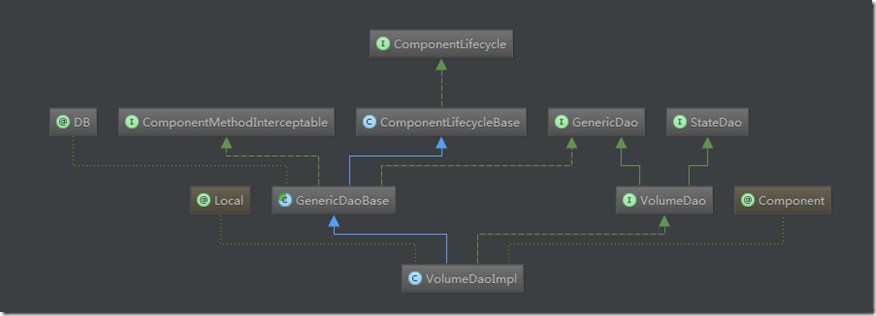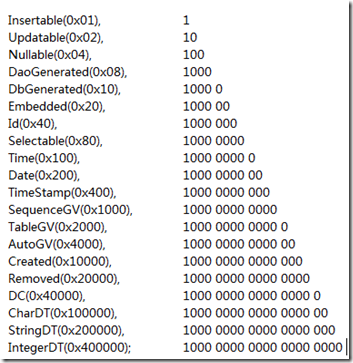今天在开发中发现一个问题,本来想对一个VO对象的removed值赋值,然后去update一下这条记录,一个最简单的set方法,但是在调用时直接抛异常了。
1: public void setRemoved(Date removed) {
2: this.removed = removed;
3: }
当时很诧异,没有想到这地方会出问题,后来看代码才发现原来cs在这里有拦截器,com.cloud.utils.db.UpdateBuilder#intercept
1: @Override
2: public Object intercept(Object object, Method method, Object[] args, MethodProxy methodProxy) throws Throwable {
3: String name = method.getName();
4: if (name.startsWith("set")) {
5: String field = methodToField(name, 3);
6: makeChange(field, args[0]);
7: } else if (name.startsWith("incr")) {
8: makeIncrChange(name, args);
9: } else if (name.startsWith("decr")) {
10: makeDecrChange(name, args);
11: }
12: return methodProxy.invokeSuper(object, args);
13: }
所有set开头的方法都被拦截,转调com.cloud.utils.db.UpdateBuilder#makeChange
1: protected Attribute makeChange(String field, Object value) {
2: Attribute attr = _dao._allAttributes.get(field);
3:
4: assert (attr == null || attr.isUpdatable()) : "Updating an attribute that's not updatable: " + field;
5: if (attr != null) {
6: if (attr.attache == null) {
7: _changes.put(field, new Ternary<Attribute, Boolean, Object>(attr, null, value));
8: } else {
9: if (_collectionChanges == null) {
10: _collectionChanges = new HashMap<Attribute, Object>();
11: }
12: _collectionChanges.put(attr, value);
13: }
14: }
15: return attr;
16: }
在那句assert那里,会判断attr是否可以update。
Attribute是cloudstack的基类GenericDaoBase中保存的对象属性集合,是一个保存了数据表的列名以及列属性的Map对象,这个对象通过Java JPA来进行持久化。
每一个干活的DAO对象都会继承于GenericDaoBase,并且实现自己这类对象的接口,如下图:
刚才说的那个isUpdatable()是个人认为cloudstack中有关数据库权限做的很精巧的地方
1: public final boolean isUpdatable() {
2: return Flag.Updatable.check(flags);
3: }
这里面会调用Flag这个enum对象的check方法,那个flags同样也是在调用Attribute的构造方法时生成的,它根据数据库表的每一列的属性,按照一个逻辑去计算相关的权限,flags的初始值为0,然后针对每一种权限依次去做或运算,最后保存为一个值,遇到需要校验权限的地方,就用下面的check方法,看传进来的权限,比如Flag.Updatable,与flags去与运算,如果与完了的结果与传进来的权限值一样,那么可以继续进行,否则就会由于assert计算表达式的结果为false而退出去。
1: public boolean check(int value) {
2: return (value & place) == place;
3: }
今天的问题就在这,Attribute.flags的值导致assert的表达式结果为false,在初始化时,flags的值明明为135(128+4+2+1),但是在实际计算时却不是这个值,一度很不解。但是为了解决生产环境的问题,不能在这个细节上耽搁太久,于是换了个思路,尝试着调用DAO的remove方法,也能实现针对数据库表的removed字段赋值。具体到为什么flags的值变了,还需要抽时间好好研究一下。
不过值得欣慰的是,如果不是set时抛异常了,自己可能也不会去啃这部分代码来了解。
附1,计算flags时的代码(com.cloud.utils.db.Attribute#setupColumnInfo):
1: protected void setupColumnInfo(Class<?> clazz, AttributeOverride[] overrides, String tableName, boolean isEmbedded, boolean isId) {
2: flags = Flag.Selectable.setTrue(flags);
3: GeneratedValue gv = field.getAnnotation(GeneratedValue.class);
4: if (gv != null) {
5: if (gv.strategy() == GenerationType.IDENTITY) {
6: flags = Flag.DbGenerated.setTrue(flags);
7: } else if (gv.strategy() == GenerationType.SEQUENCE) {
8: assert (false) : "Sequence generation not supported.";
9: flags = Flag.DaoGenerated.setTrue(flags);
10: flags = Flag.Insertable.setTrue(flags);
11: flags = Flag.SequenceGV.setTrue(flags);
12: } else if (gv.strategy() == GenerationType.TABLE) {
13: flags = Flag.DaoGenerated.setTrue(flags);
14: flags = Flag.Insertable.setTrue(flags);
15: flags = Flag.TableGV.setTrue(flags);
16: } else if (gv.strategy() == GenerationType.AUTO) {
17: flags = Flag.DaoGenerated.setTrue(flags);
18: flags = Flag.Insertable.setTrue(flags);
19: flags = Flag.AutoGV.setTrue(flags);
20: }
21: }
22:
23: if (isEmbedded) {
24: flags = Flag.Embedded.setTrue(flags);
25: }
26:
27: if (isId) {
28: flags = Flag.Id.setTrue(flags);
29: } else {
30: Id id = field.getAnnotation(Id.class);
31: if (id != null) {
32: flags = Flag.Id.setTrue(flags);
33: }
34: }
35: column = field.getAnnotation(Column.class);
36: if (gv == null) {
37: if (column == null || (column.insertable() && column.table().length() == 0)) {
38: flags = Flag.Insertable.setTrue(flags);
39: }
40: if (column == null || (column.updatable() && column.table().length() == 0)) {
41: flags = Flag.Updatable.setTrue(flags);
42: }
43: if (column == null || column.nullable()) {
44: flags = Flag.Nullable.setTrue(flags);
45: }
46: Encrypt encrypt = field.getAnnotation(Encrypt.class);
47: if (encrypt != null && encrypt.encrypt()) {
48: flags = Flag.Encrypted.setTrue(flags);
49: }
50: }
51: ElementCollection ec = field.getAnnotation(ElementCollection.class);
52: if (ec != null) {
53: flags = Flag.Insertable.setFalse(flags);
54: flags = Flag.Selectable.setFalse(flags);
55: }
56:
57: Temporal temporal = field.getAnnotation(Temporal.class);
58: if (temporal != null) {
59: if (temporal.value() == TemporalType.DATE) {
60: flags = Flag.Date.setTrue(flags);
61: } else if (temporal.value() == TemporalType.TIME) {
62: flags = Flag.Time.setTrue(flags);
63: } else if (temporal.value() == TemporalType.TIMESTAMP) {
64: flags = Flag.TimeStamp.setTrue(flags);
65: }
66: }
67:
68: if (column != null && column.table().length() > 0) {
69: table = column.table();
70: }
71:
72: columnName = DbUtil.getColumnName(field, overrides);
73: }
附2,数据库表每一列可能的所有权限列表:

